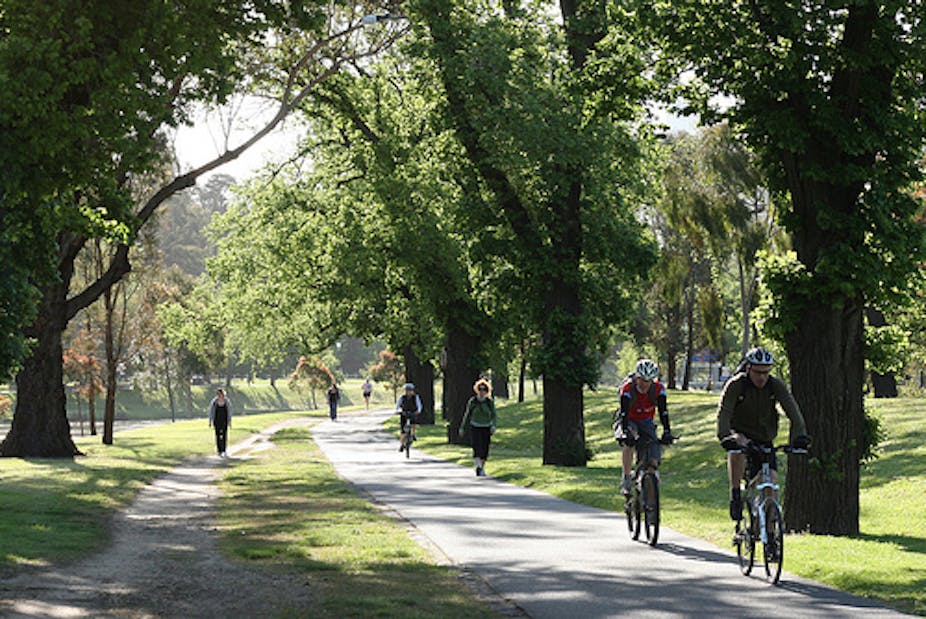Recent patterns of residential development in Australian cities are threatening to overwhelm green space in our urban cores. Policies of urban consolidation have concentrated medium to high density residential development in inner ring suburbs where green space is comparatively scarce. And the zoning and development regulations of many local authorities actually allow a reduction of green space for higher density development – usually without any justification.
Everyone likes parks, but we may be greatly undervaluing their importance to our health and wellbeing, and to the wellbeing of other species. Rather than losing our green spaces, we should be assessing the evidence on their value and making informed decisions about how much green space we need.
To the casual observer, urban parks and green spaces might appear commonplace. But even a cursory examination of green space distribution within most cities shows that urban green space is neither uniformly accessible nor equitably distributed.

Generally the older and denser parts of many cities, which often were developed during the industrial revolution, tend to have relatively poor park access. But suburbs that have developed since the late 1950s have comparatively better access to various types of green space.
The spatial pattern of urban green space distribution reflects diverse factors linked to urban land and property markets, changing land use planning philosophies, histories of settlement and development, and in some cases, institutionalised racism and elitism.
Before the development of formalised park and recreation planning systems in the late 1800s and early 1900s, park and green space planning in the United Kingdom, United States, and Australia was relatively haphazard.
Some cities, like Adelaide, are park rich due to visionary administrators. In London royal parks were opened to the public, a product of elite benevolence. Other cities, like Canberra, grew while new ideas about park planning gained popularity.
But some cities are park poor. Inner ring residents in Los Angeles for example, have less public park space per 1,000 residents than the size of a suburban backyard. So can we put a value on urban green space?
Research by John Henneberry, a Professor of Town and Regional Planning at the University of Sheffield, suggests people in Sheffield may be willing to pay sizeable sums to access high quality urban green space.
This should not come as a surprise. From their early origins in the UK and US, parks were known to raise property values and people were prepared to pay a premium to live near them. Frederick Law Olmsted and Harland Bartholomew openly acknowledged this when they developed Central Park in New York.

Studies by John Crompton and others have found widespread evidence supporting the notion that proximity to green and open space pushes up property values. But reducing the benefit of parks and green space to a line on a ledger sheet can be both misleading and inaccurate.
Beyond an economic calculation, researchers have discovered that urban green spaces provide a wide variety of benefits. You don’t have to use these spaces to benefit from them. Parks can improve physical and mental health, ecosystem services and urban biodiversity.
Public health researchers like Ariane Bedimo-Rung and Billie Giles-Corti have found that living close to urban green spaces like parks and trails can increase urban residents’ levels of physical activity and reduce the likelihood of being overweight or obese. This reduces the risk of diabetes and several types of cancer.
Frances Kuo and her colleagues have found that proximity to urban green space can lower the incidence of domestic violence, stress and depression and may even mitigate attention deficit disorder in children.
Ecological economists including Per Bolund and Sven Hunhammar have found urban green spaces also provide a range of free ecosystem services. They reduce noise levels, lower pollution, and reduce flooding. And some ecologists have also found that urban parks can harbour rare and endangered species and promote biodiversity.
We need strong evidence to support the density imperative, evidence that we presently lack. Until we can accurately gauge the green space needs of higher density residents, it may be folly to blindly pursue policies of urban consolidation.
In a time of economic uncertainty, when local councils are looking to develop “surplus” land assets such as “underutilised” park spaces, we need to carefully evaluate the true values of these spaces, before they are sold off to bolster ailing municipal coffers. To do otherwise could be more costly than we might imagine.

